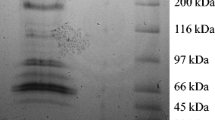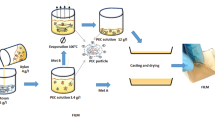Abstract
Cellulase and xylanase from Trichoderma reesei were immobilized simultaneously on Eudragit L-100, a reversibly soluble polymer. The effects of polymer concentration and polymer precipitation pH on enzyme activity recovery were investigated at an enzyme complex concentration of 1%. The immobilization mechanism of cellulase and xylanase on the polymer was discussed. An activity recovery of 75% and 59% was obtained for the cellulase and the xylanase, respectively, under the condition of a polymer concentration at 2% and a polymer precipitation pH at 4.0. Most zymoproteins might be connected to the polymer by electrostatic attraction in a medium of pH 4.8. In addition, the covalent coupling between the zymoproteins and the polymer was demonstrated by the infrared spectrograms. It was suggested that dehydration–condensation reaction occurred between the zymoproteins and the polymer during the immobilization.







Similar content being viewed by others
References
Min, N. Z., & Wu, W. (2000). Green chemistry and engineering (in Chinese). Beijing: Chemical Industry Press.
Himan, N. D., Schell, D. J., Riley, J., Bergeron, P. W., & Walter, P. J. (1992). Preliminary estimate of the cost of ethanol production for SSF technology. Applied Biochemistry and Biotechnology, 34, 639–649.
He, X., Miao, Y., Jiang, X., Xu, Z., & Ouyang, P. (2010). Enhancing the enzymatic hydrolysis of corn stover by an integrated wet-milling and alkali pretreatment. Applied Biochemistry and Biotechnology, 160, 2449–2457.
Fujimura, M., Mori, T., & Tosa, T. (1987). Preparation and properties of soluble–insoluble immobilized proteases. Biotechnology and Bioengineering, 29, 747–752.
Cao, L. Q. (2005). Carrier-bound immobilized enzymes: principles, application and design. New Jersey: Wiley.
Sardar, M., Ipsita, R., & Gupta, M. N. (2000). Simultaneous purification and immobilization of Aspergillus niger xylanase on the reversible soluble polymer Eudragit TM L-100. Enzyme and Microbial Technology, 27, 672–679.
Dourado, F., Bastos, M., Mota, M., & Gama, F. M. (2002). Studies on the properties of Celluclast/Eudragit L-100 conjugate. Journal of Biotechnology, 99, 121–131.
Saelee, N. (2007). The production of fungal mannanase, cellulase and xylanase using palm kernel meal as substrate. Walailak Journal of Science and Technology, 4, 67–82.
Xu, Z., Miao, Y., Chen, JY., Jiang, X., He, X., Ouyang, P., (2009) Co-immobilization of cellulase and xylanase using a reversibly soluble–insoluble carrier (in Chinese). Biotechnol Business, extra edn, 162–168.
Margolin, A. L., Sherstyuk, S. F., Izumrudov, V. A., Zezin, A. B., & Kabanov, V. A. (1985). Enzymes in polyelectrolyte complexes. The effect of phase transition on thermal stability. European Journal of Biochemistry, 146, 625–632.
Mandels, M., Andreotti, R., & Roche, C. (1976). Measurement of saccharifying cellulase. Biotechnology and Bioengineering Symposium, 6, 21–33.
Bailey, M. J., Biely, P., & Poutanen, K. (1992). Interlaboratory testing of methods for assay of xylanase activity. Journal of Biotechnology, 23, 257–270.
Miller, G. L. (1959). Use of dinitrosalicylic acid reagent for determination of reducing sugar. Analytical Chemistry, 31, 426–428.
Bradford, M. M. (1976). A rapid and sensitive method for the quantitation of microgram quantities of protein utilizing the principle of protein-dye binding. Analytical Biochemistry, 72, 248–254.
Ferraro, J. R., & Laboratories, S. R. (1982). The Sadtler infrared spectra handbook of minerals and clays. Philadelphia: Sadtler.
Terri, T. T. (1997). Crystalline cellulose degradation: new insight into the function of cellobiohydrolases. Trends in Biotechnology, 15, 160–167.
Prade, R. A. (1996). Xylanases: from biology to biotechnology. Biotechnology & Genetic Engineering Reviews, 13, 101–131.
Sun, W. C., Cheng, C. H., & Lee, W. C. (2008). Protein expression and enzymatic activity of cellulases produced by Trichoderma reesei Rut C-30 on rice straw. Process Biochemistry, 43, 1083–1087.
Roberge, M., Dupont, C., Morosoli, R., Shareck, F., & Kluepfel, D. (1997). Asparagine-127 of xylanase A from Streptomyces lividans, a key residue in glycosyl hydrolases of superfamily 4/7: kinetic evidence for its involvement in stabilization of the catalytic intermediate. Protein Engineering, 10, 399–403.
Lewin, B. (2007). Genes IX. Boston: Jones & Bartlett.
Taniguchi, M., Hoshino, K., Watanable, K., Sugai, K., & Fujii, M. (1992). Production of soluble sugar from cellulosic materials by repeated use of a reversibly soluble-autoprecipitating cellulase. Biotechnology and Bioengineering, 39, 287–292.
Cong, L., Kaul, R., Dissing, U., & Mattiasson, B. (1995). A model study on Eudragit and polyethyleneimine as soluble carriers of α-amylase for repeated hydrolysis of starch. Journal of Biotechnology, 42, 75–84.
Hoshino, K., Taniguchi, M., Ueoka, H., Ohkuwa, M., Chida, C., Morohashi, S., et al. (1996). Repeated utilization of β-glucosidase immobilized on a reversibly soluble–insoluble polymer for hydrolysis of phloridzin as a model reaction producing a water-insoluble product. Journal of Fermentation and Bioengineering, 82(3), 253–258.
Smith, E., Zhang, Q., Shen, J., Schroeder, M., & Sliva, C. (2008). Modification of Esperase by covalent bonding to Eudragit polymers L 100 and S 100 for wool fibre surface treatment. Biocatalysis and Biotransformation, 26(5), 391–398.
Zhang, Y., Xu, J., Yuan, Z., Xu, H., & Yu, Q. (2010). Artificial neural network — genetic algorithm based optimization for the immobilization of cellulase on the smart polymer Eudragit L-100. Bioresource Technology, 101(9), 3153–3158.
Sardar, M., Agarwal, R., Kumar, A., & Gupta, M. N. (1997). Noncovalent immobilization of enzymes on an enteric polymer Eudragit S-100. Enzyme and Microbial Technology, 20, 361–367.
Acknowledgment
This research project was financially supported by a grant of the National Natural Science Foundation of China and the People’s Government of Guangdong Province (U0733001) and a grant of National Basic Research Program of China (973 Program, 2009CB724700). The authors would like to thank Novozymes Investment for providing the commercial enzyme complex.
Author information
Authors and Affiliations
Corresponding author
Rights and permissions
About this article
Cite this article
Xu, Z., Miao, Y., Chen, J.Y. et al. Co-immobilization Mechanism of Cellulase and Xylanase on a Reversibly Soluble Polymer. Appl Biochem Biotechnol 163, 153–161 (2011). https://doi.org/10.1007/s12010-010-9024-y
Received:
Accepted:
Published:
Issue Date:
DOI: https://doi.org/10.1007/s12010-010-9024-y




